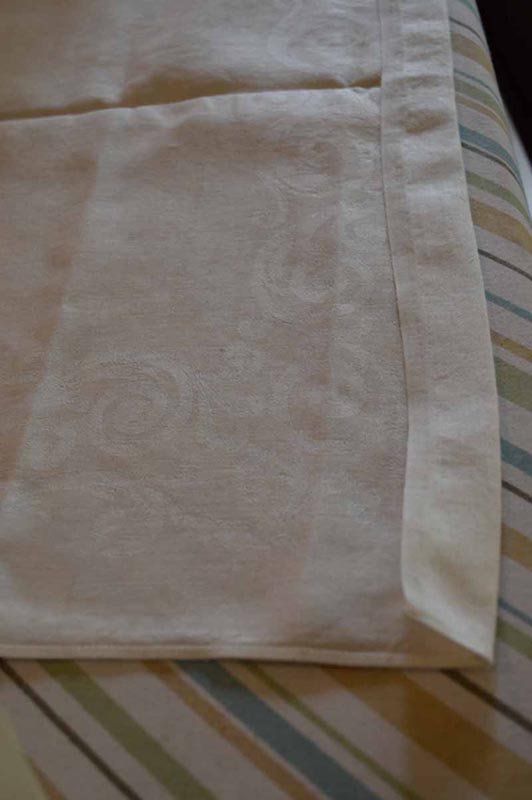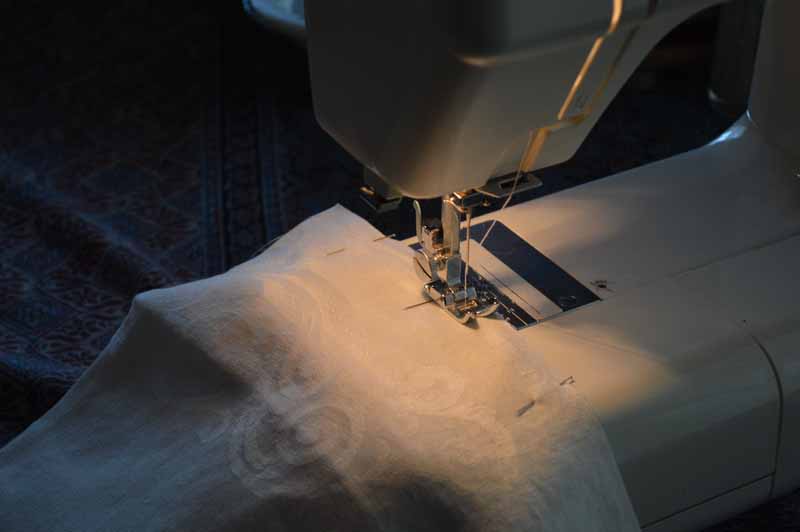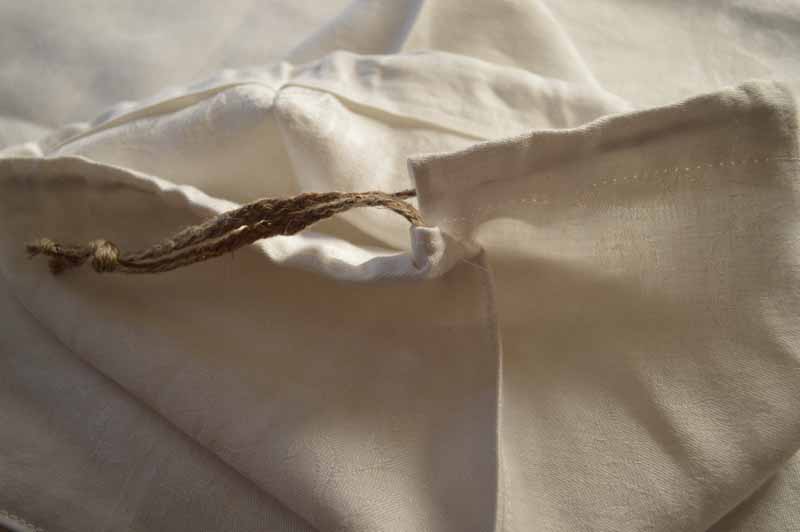Make linen bread bags in just 15 minutes – no more moldy bread
By Chris Dalziel, contributing writer
Get rid of plastic bread bags
My family doesn’t go through bread very fast. I bake 2 loaves of challah each week, and inevitably more than half the second loaf is wasted due to moldy bread. Up till now we stored our bread in plastic bags. So not only is the bread wasted, but the plastic bread bags are sent to the landfill, too. Once there is mold in the bag you can’t clean it out.
There’s too much plastic waste in the world already and I didn’t want to be responsible for creating more. I’ve been on a zero-waste mission this year, so I was serious about solving this problem.

I had a wooden bread box, but that wasn’t a good solution. The bread box takes up too much room on the kitchen counter.
After searching for a few years I think I’ve finally found the solution to my moldy bread problem. And I found it at the thrift store for under a dollar.
My local thrift stores often have 100% linen napkins for sale. Linen is the perfect fabric for storing bread. The French have known this for centuries. After all, that’s what they used to store bread in before plastic bags came along.
Check out this post to know if your treasure is linen or cotton.
Benefits of linen bread bags:
Linen is the ideal fabric for storing bread. Linen is:
- Breathable
- Keeps the bread in the dark
- Bread bag can be hung on a hook off the counter
- Washable
- Keeps bread from drying out
- Linen naturally attracts moisture
- You can hang your bread with the drawstring so you won’t lose it under armloads of produce.
Common sizes of linen bread bags
Here are the finished sizes of common linen bread bags:
Baguettes and Challah – 17″ x 11″ (Use a 22″ x 22″ napkin for this size)
Boules – 12″ x 12″
Sandwich loaves – 15″ x 12″
Make a linen bread bag from upcycled linen dinner napkins
Skill level: Beginner
Time: 15 minutes
Tools needed:
- Sewing machine with straight stitch
- Scissors or a way to cut the thread
Supplies:
- Thread to match your napkin fabric
- 1 – 100% linen dinner napkin — square with a plain edge. Choose a heavier linen fabric over a fine linen fabric. I used a 22″ x 22″ napkin.
- 27″ length of ½” ribbon, braided seine twine, heavy jute string, or fancy kumihimo braid
I found two beautiful, never used, double damask linen dinner napkins at the thrift store for $1.50 (for both!). These were 24″ x 24″ before washing and ironing. They shrunk down to 22″ x 22″, the perfect size for a long artisan loaf of bread. The finished bread bag will be 21 inches long and 11 inches wide – ample for baguettes, challah, and other long artisan loaves.
If the finished bread bag seems too roomy for smaller loaves, simply secure it closer to the loaf.
Tutorial:
Prepare the fabric
Wash and iron the dinner napkin before you begin. This cleans and preshrinks the fabric and makes it easier to work with.
Decide on which is the right side of your napkin. With some woven designs like double damask it may be hard to determine which side is the right side. Check which way the hem is folded. That may give you a hint.

Make the string casing
With the wrong side of the napkin facing you, fold over the top edge of the napkin toward you, three-quarters of an inch. Pin in place and press. Stitch close to the edge of the napkin, away from the fold, to make a ¾” casing for the string. Leave the ends open.

Stitch the bottom and side seams
Fold the napkin right sides together, with the stitched casing at the top. Pin the bottom edge and the open side edge together. Begin at the bottom corner, at the fold line. Stitch along the bottom edge allowing ¼ inch seam. Turn the work and continue stitching up the open side, stopping just before the casing.
Turn right side out
Open the napkin-bag right side out and steam press the seams
Trim any lose threads. Use a pin to pull out the corner edge to make crisp corners. Press the corners.
Topstitch the edges
Topstitch on the right side, ¼” from the finished edge. Begin on the folded edge, just after the casing. Top stitch around the bag, across the bottom and on the stitched side, stopping just before the casing starts. Leave the casing free of stitching.

Place the draw string
Cut a ribbon or thick piece of seine twine, or a fancy braid, 27″ long. Using a large safety pin, pull the twine, braid, or ribbon through the casing at the top of the linen bag. Stop before you’ve pulled it all the way out. You’ll have two ends with the middle part inside the casing. Take the two ends of the twine and tie them with an overhand knot. Viola! Your bread bag is complete.
Embellish it if you like:
This is a quick tutorial, but you can exercise your creativity on the finished bread bag with embroidery, stenciling, or fabric paint. Avoid beading. Beads can make the linen more difficult to iron.
Your bread bags are ready for your homemade bread!

























No comments:
Post a Comment